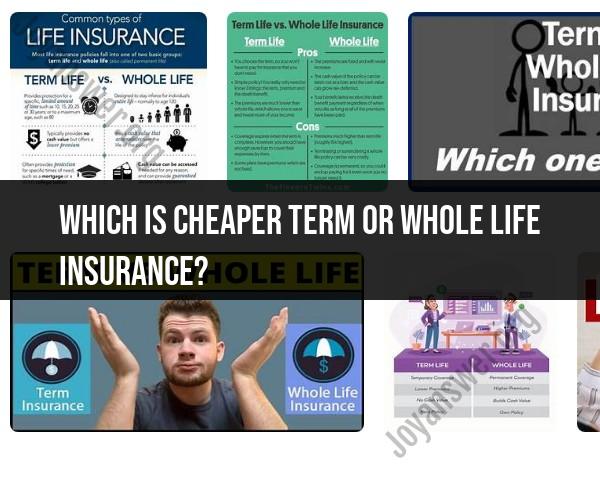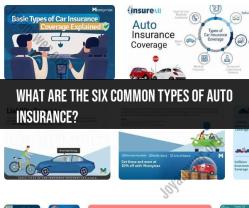Which is cheaper term or whole life insurance?
In general, term life insurance is cheaper than whole life insurance. The primary reason for this cost difference is the fundamental distinction between the two types of insurance.
Term Life Insurance:
- Term life insurance provides coverage for a specified term, such as 10, 20, or 30 years.
- It offers pure death benefit protection without any cash value or investment component.
- Premiums are typically lower, especially for younger and healthier individuals.
- As you're only paying for the death benefit, it is more affordable in the short term.
Whole Life Insurance:
- Whole life insurance provides lifetime coverage.
- It includes a savings or investment component, known as the cash value, which grows over time.
- Premiums are significantly higher compared to term life insurance, as they fund both the death benefit and the cash value component.
- Whole life insurance can be used as an investment vehicle, but it is more expensive in terms of premiums.
So, if you're primarily concerned about affordability and simply want a death benefit to protect your loved ones during a specific period, term life insurance is usually the more cost-effective option.
However, it's important to note that the choice between term and whole life insurance should depend on your individual financial goals and needs. Whole life insurance can build cash value and provide coverage for life, which may be appealing to some individuals. When making a decision, it's essential to consider factors like your financial situation, long-term goals, and how the policy fits into your overall financial plan. It's a good idea to speak with a financial advisor or insurance agent who can help you determine the best insurance option for your specific circumstances.
Choosing Between Term and Whole Life Insurance: Which Is Cheaper?
Term life insurance is generally much cheaper than whole life insurance. This is because term life insurance provides coverage for a set period of time, while whole life insurance provides coverage for your entire life. Additionally, whole life insurance policies have a cash value component, which means that a portion of your premiums are invested and grow over time. This cash value can be accessed while you are still alive, but it will reduce the death benefit that your beneficiaries receive.
Here is a comparison of the average monthly premiums for a 30-year-old male in good health, according to the Insurance Information Institute:
- Term life insurance: $26 per month
- Whole life insurance: $451 per month
As you can see, whole life insurance is significantly more expensive than term life insurance. However, it is important to note that these are just averages and your individual rates may vary depending on your age, health, and other factors.
A Cost-Benefit Analysis of Term Life vs. Whole Life Insurance
When choosing between term and whole life insurance, it is important to consider your individual needs and financial goals. If you are looking for affordable coverage for a specific period of time, such as to protect your family's finances while your children are young or to pay off a mortgage, then term life insurance is a good option.
If you are looking for lifelong coverage and the ability to build cash value, then whole life insurance may be a good option for you. However, it is important to be aware of the high premiums and the fact that the cash value component may not grow as quickly as other investment options.
Comparing Premiums, Coverage, and Benefits
Here is a table comparing the premiums, coverage, and benefits of term and whole life insurance:
| Feature | Term life insurance | Whole life insurance |
|---|---|---|
| Premiums | Generally low | Generally high |
| Coverage | For a set period of time | For your entire life |
| Death benefit | Yes | Yes |
| Cash value | No | Yes |
| Other benefits | May offer additional benefits, such as riders for living benefits or disability income | May offer additional benefits, such as estate planning and guaranteed purchase options |
Deciding on the Right Insurance Type for Your Financial Goals
When deciding on the right insurance type for you, it is important to consider your individual needs and financial goals. Here are some questions to ask yourself:
- How much coverage do I need?
- How long do I need coverage for?
- Can I afford the premiums?
- Do I need a cash value component?
- What other benefits are important to me?
Once you have considered your needs and goals, you can start shopping for quotes from different insurance companies. It is important to compare quotes from multiple companies to get the best deal.
Combining Term and Whole Life Insurance for Optimal Coverage
Some people choose to combine term and whole life insurance to get the best of both worlds. For example, you could purchase a term life insurance policy to cover your immediate needs, such as paying off a mortgage or supporting your family while your children are young. Then, you could purchase a whole life insurance policy to provide lifelong coverage and build cash value.
Another option is to purchase a convertible term life insurance policy. This type of policy allows you to convert your term life insurance policy to a whole life insurance policy at a later date, without having to go through a medical exam.
Conclusion
When choosing between term and whole life insurance, it is important to consider your individual needs and financial goals. Term life insurance is generally more affordable than whole life insurance, but it only provides coverage for a set period of time. Whole life insurance provides lifelong coverage and has a cash value component, but it is more expensive.
You may also want to consider combining term and whole life insurance for optimal coverage. This could involve purchasing a term life insurance policy to cover your immediate needs and a whole life insurance policy to provide lifelong coverage and build cash value. Another option is to purchase a convertible term life insurance policy, which allows you to convert your term life insurance policy to a whole life insurance policy at a later date.
It is important to shop around and compare quotes from different insurance companies before you make a decision. You should also consult with a financial advisor to discuss your individual needs and to get help choosing the right insurance policy for you.













